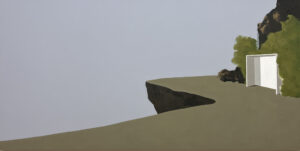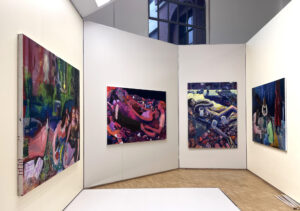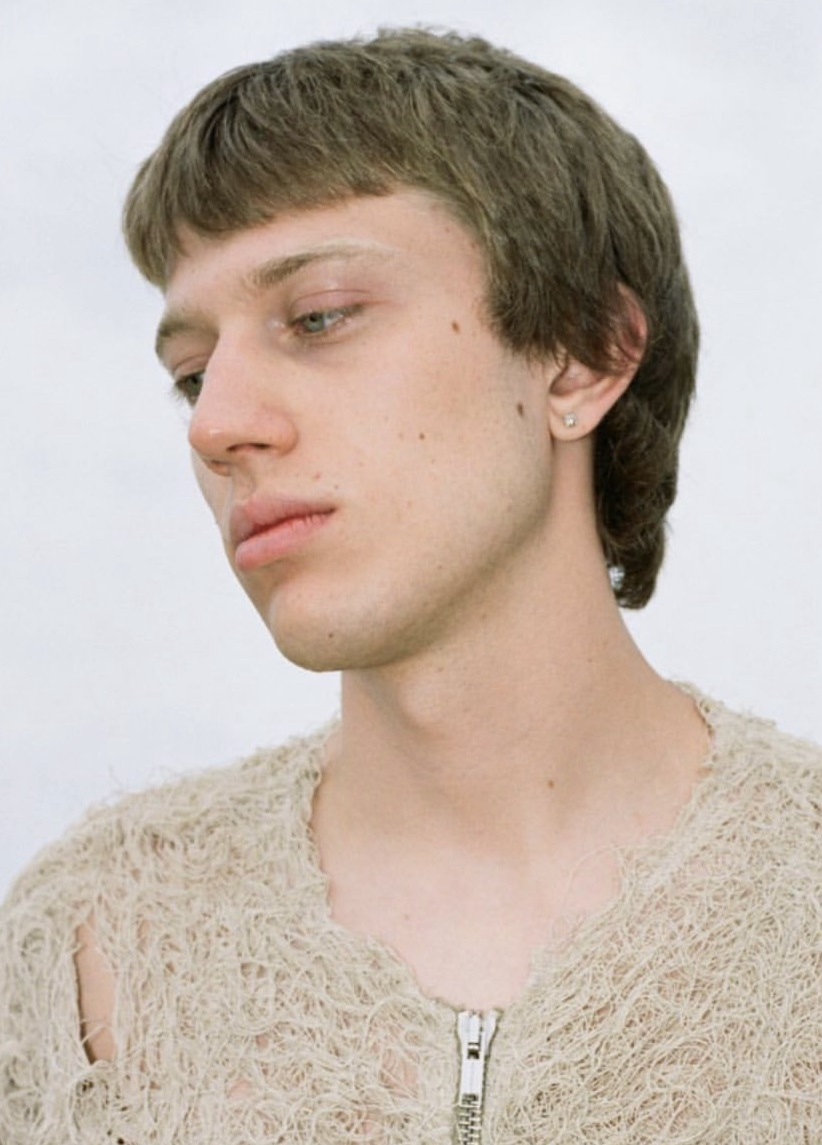At Triennale di Milano the exhibition “Italian Painting Today”, curated by Damiano Gullì, offers a wide selection of contemporary painting, with 120 artists on show, born between 1960 and 2000, each called to present one work made between 2020 and 2023. Painting returns as a protagonist in the spaces of Triennale, to which it is historically linked by at least one exhibition, “Mural painting and decorative sculpture”, curated by Mario Sironi in 1933 with works by de Chirico, Carrà and Severini. Ninety years after the exhibition which, in the fascist era, wanted to bring painting and architecture closer together, the Milanese institution led by Stefano Boeri aims to restore a dialogue between the two disciplines and open the doors to the idea of “designing together”. “Italian Painting Today” wants to testify that painting is still the leading medium for numerous artists, and at the same time it aims to build an “emotional” map based on years of research, reports and studio visits conducted by the curator.

AA.VV., Pittura italiana oggi, installation view, ph. Piercarlo Quecchia dsl studio, courtesy Triennale Milano
This kind of painting is fully aware of its history, with which it engages in a dialogue, rather than a controversy. This confrontation leaves room to a freedom of style and content that places its gaze on the ever faster changes of the present, immersed in the dialectics between individual and collective. The result is a polyphony in which different voices coexist, as well as visions that do not feel the need to reconcile with each other or to adhere to specific trends, demonstrating that they can cohabit in the same space. The setting-up of the exhibition, signed by Studio Italo Rota, wants to put these premises into practice, allowing the visitor to undertake a free route, with multiple possibilities. The rooms on the upper floor are articulated in passages with modular panels that at the same time reveal and conceal the paintings on show, creating unexpected juxtapositions by bringing closer works that are actually distant from each other. The light of the lamps embedded in the panels tries to recreate the atmosphere of the artist’s studio, pulling the spectators closer to a laboratorial dimension. The opening of the exhibition is a large abstract work by Gianni Politi, a portal composed of a collage of colour blocks, shades, spurts and drippings that quotes the altarpiece by Tiziano in the Basilica dei Frari in Venice and rielaborates the combination of pure colours and the ancient chromatisms of the Venetian masters. Two recurring themes are introduced in many of the exhibited works: the dialogue with the masters of painting from the past and the fluid relationship between figuration and abstraction that patch things up, intermingle and amalgamate.

From left to right: Pesce Khete, Senza Titolo, 2021, mixed media on canvas; Enrico David, Fossa Madre, 2020, acrylic on canvas, 185 x 110 cm, courtesy Triennale Milano
The first set of works in the panel system is dense in color and details. The human figure is prominent and immediately brings the observer into the dimension of the Ego. An alternation of darkness and light, given by bright colors on neon shades, characterizes ambiguous scenes, suspended relationships between characters who embrace each other, stand side by side or do not meet at all. In the room on the left stands out for small size and simplicity of forms La pagliacciata by Narcisa Monni. The work depicts a man carrying a woman on his shoulder, a playful and loving gesture that becomes disturbing. We feel the weight of such gesture. The two figures come towards the observer threateningly, with their zombie-like appearance, as they were empty or troubled souls. The observer is also baffled by the detailed representation of their teeth in relation to the bodies, sharply outlined but sketched with quick brushes in the inner part. Where do we come from? Where are we going? The direction is not the right one, but it seems impossible to stop.

From left to right: Narcisa Monni, La pagliacciata, 2021, acrylic on paper; Marta dell’Angelo, Grumo, 2023, oil painting on canvas, courtesy Triennale Milano
Pesce Khete’s work evokes a dream, a creative furor and a brain explosion at the same time. Shapes and colors are intertwined and overlapped, until some take over others. It is as if they merged into a photograph sampled by the flow of an experiential Ego that tries to be absolute in the act of defining itself. In another room, a completely black rectangle breaks the sequence of images and figures: it seems a sort of invitation to take a pause for meditating; the blackness of the shape sucks the light by introducing the abyss, the oblivion, a memory lapse. However, by looking closer, the surface is not uniform, but knurled and glossy, revealing the wood graining on which the paint is spread. Something sounds odd. The caption sayss: “Daniele Milvio, Untitled, mixed technique on canvas”. The Genoese artist uses the medium to overcome the materiality of the canvas, its texture, deceiving the gaze and triggering tactile, three-dimensional suggestions, staging the monochrome.

AA.VV., Pittura italiana oggi, installation view, ph. Piercarlo Quecchia dsl studio, courtesy Triennale Milano
Chiara Enzo’s work, Accidente, is an extremely well-defined small canvas that depicts a girl in the act of pulling on her hair and showing a mole on her nape. The detail previously hidden by the hair is an intimate identity mark that no longer needs to be concealed. The body, once again, is at the core of the work by Marta Dell’Angelo in the form of an entangled mass that proliferates into a plurality of inextricable limbs. In Fossa madre by Enrico David, on the other hand, the body is pale and fragile, encompassed into a natural cove, as if it were resting. The body disappears in the canvas by Pierpaolo Curti leaving the observer on the threshold of a vast nothingness. The lack of physical contact with other people leads to a rediscovery of one’s own body, vulnerable, imperfect, unique. Bodies, nowadays, appear wounded, full of contradictions, and the works on show testify to the therapeutic function of painting. Painting, in other words, is a practice that Stefano Boeri defines as “a violent form of resistance to the contemporary world, which produces very dense artifacts, filled with days, hours”.

Pierpaolo Curti, Station, tecnica mista, 200 x 100 cm, courtesy Triennale Milano
The last three years have been those of the pandemic, of claustrophobic isolation, and at the same time of unbridgeable distances: On the one hand we have suffered from the lack of human warmth, on the other we have felt the need to be at ease with ourselves in order to overcome this tragic moment. But these have also been the years of activism, of the pervasiveness of social networks and algorithms, and of a public opinion increasingly divisive and manipulable through artificial intelligence, which – in its generative declination – calls into question the principle of authorship. The works on display, although deeply aware of their time, do not shout aggressive statements, but rather confront issues in a delicate way, without hostile intentions. Leaving the exhibition, you have the impression of having visited a multiverse in which the canvases are portals, each of which leads to a different dimension. It feels like sliding from dream to reality, from crowd to loneliness, and eventually to absence. From female, to male, to neutral. From comfortable to unhospitable. From full to empty. As if there were something between one work and another, an indefinite space.

AA.VV., Pittura italiana oggi, ph. Enrico Boschi per Juliet, courtesy Triennale Milano
Images circulate freely, unbothered: They do not need any justification, one does not exclude the other. An unequivocal justification of the exhibition, for an institution of the stature of the Triennial, is the duty to bring to the attention of as many people as possible the new trends of art and to support the Italian art scene. Damiano Gullì chooses to restrict the field to the painted canvas, taking as well into account its possibility of expanding in space. This is where the debate begins: Why painting and not other media? Why this distinction? You can discuss the choice of artists, the selection of works and the setting-up of the exhibition, but of this is well aware the Milanese institution, that with “Italian Painting Today” intends to produce debate, reflections and discourses.
Info:
AA.VV. Pittura italiana oggi
24/10/2023- 11/02/2024
Triennale Milano – Viale Emilio Alemagna, 6, 20121 Milano MI
https://triennale.org

Born in Bologna, he studies fashion design and multimedia arts at the IUAV in Venice. He believes in the possibility of crossing boundaries between disciplines and that art can have an active role in breaking down inequalities and uniting people by creating communities.






NO COMMENT